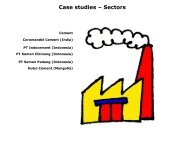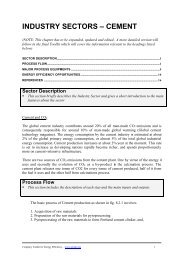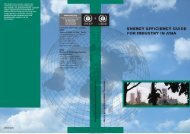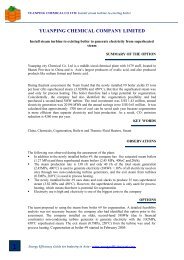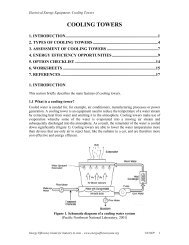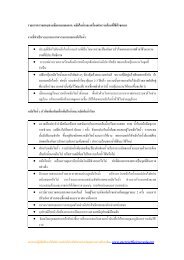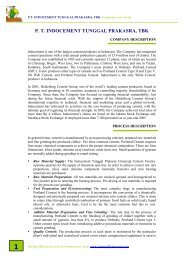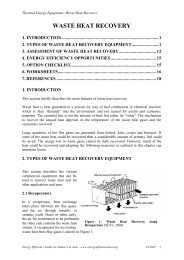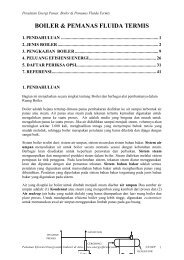Chapter - Fuels and Combustion - RETScreen International
Chapter - Fuels and Combustion - RETScreen International
Chapter - Fuels and Combustion - RETScreen International
Create successful ePaper yourself
Turn your PDF publications into a flip-book with our unique Google optimized e-Paper software.
Thermal Equipment: <strong>Fuels</strong> <strong>and</strong> <strong>Combustion</strong><br />
Table 9. Typical physical <strong>and</strong> chemical properties of various gaseous fuels<br />
Fuel Gas Relative Higher Heating Air/Fuel Flame Flame<br />
Density Value kcal/Nm 3 ratiom<br />
of air to m 3 Temp. o C<br />
Speed m/s<br />
of Fuel<br />
Natural 0.6 9350 10 1954 0.290<br />
Gas<br />
Propane 1.52 22200 25 1967 0.460<br />
Butane 1.96 28500 32 1973 0.870<br />
2.3.3 LPG<br />
LPG is a predominant mixture of propane <strong>and</strong> Butane with a small percentage of unsaturates<br />
(Propylene <strong>and</strong> Butylene) <strong>and</strong> some lighter C<br />
2<br />
as well as heavier C<br />
5<br />
fractions. Included in the<br />
LPG range are propane (C<br />
3<br />
H<br />
8<br />
), Propylene(C<br />
3<br />
H<br />
6<br />
), normal <strong>and</strong> iso-butane (C<br />
4<br />
H<br />
10<br />
)<strong>and</strong><br />
Butylene(C<br />
4<br />
H<br />
8<br />
). LPG may be defined as those hydrocarbons, which are gaseous at normal<br />
atmospheric pressure, but may be condensed to the liquid state at normal temperature, by the<br />
application of moderate pressures. Although they are normally used as gases, they are stored<br />
<strong>and</strong> transported as liquids under pressure for convenience <strong>and</strong> ease of h<strong>and</strong>ling. Liquid LPG<br />
evaporates to produce about 250 times volume of gas.<br />
LPG vapour is denser than air: butane is about twice as heavy as air <strong>and</strong> propane about one<br />
<strong>and</strong> a half times as heavy as air. Consequently, the vapour may flow along the ground <strong>and</strong><br />
into drains sinking to the lowest level of the surroundings <strong>and</strong> be ignited at a considerable<br />
distance from the source of leakage. In still air vapour will disperse slowly. Escape of even<br />
small quantities of the liquefied gas can give rise to large volumes of vapour / air mixture <strong>and</strong><br />
thus cause considerable hazard. To aid in the detection of atmospheric leaks, all LPG’s are<br />
required to be odorized. There should be adequate ground level ventilation where LPG is<br />
stored. For this very reason LPG cylinders should not be stored in cellars or basements,<br />
which have no ventilation at ground level.<br />
2.3.4 Natural gas<br />
Methane is the main constituent of natural gas <strong>and</strong> accounting for about 95% of the total<br />
volume. Other components are: Ethane, Propane, Butane, Pentane, Nitrogen, Carbon<br />
Dioxide, <strong>and</strong> traces of other gases. Very small amounts of sulphur compounds are also<br />
present. Since methane is the largest component of natural gas, generally properties of<br />
methane are used when comparing the properties of natural gas to other fuels.<br />
Natural gas is a high calorific value fuel requiring no storage facilities. It mixes with air<br />
readily <strong>and</strong> does not produce smoke or soot. It contains no sulphur. It is lighter than air <strong>and</strong><br />
disperses into air easily in case of leak. A typical comparison of carbon contents in oil, coal<br />
<strong>and</strong> gas is given in the table below.<br />
Energy Efficiency Guide for Industry in Asia – www.energyefficiencyasia.org ©UNEP 10



